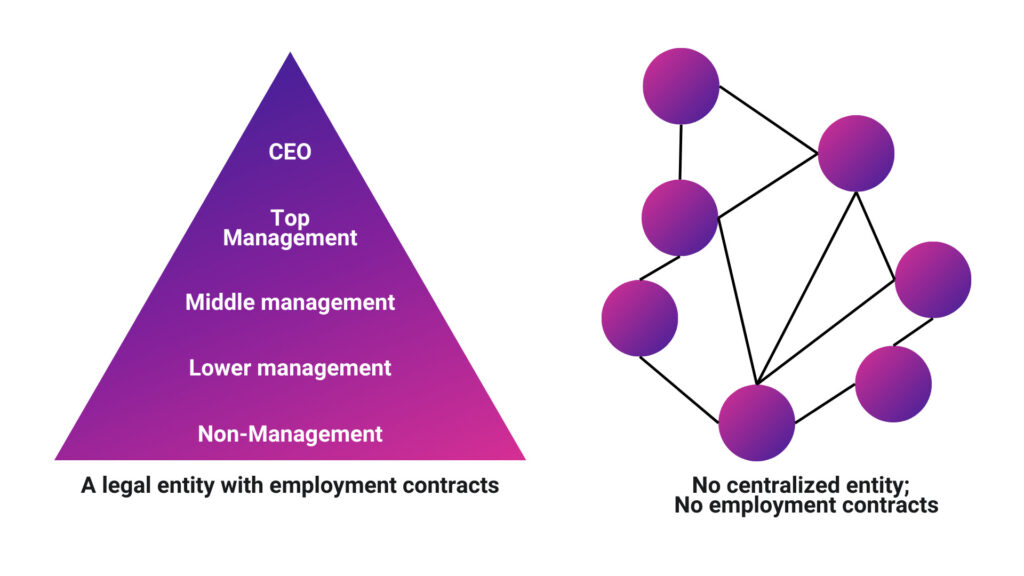Decentralized Autonomous Organizations (DAOs) Explained – What is a DAO and how does it work?
Decentralized Autonomous Organizations (DAOs) are changing business models as we know them
DAOs are collective organizations owned and managed by their members, with everyone having a voice. Many analysts and industry insiders confirm that this type of organization is gaining importance and may even replace some traditional companies.
Imagine a fully autonomous supermarket that not only takes money and gives you apples in return, but also uses that money to automatically reorder the groceries. This machine also hires cleaners to clean the supermarket and pays the store rent itself. When you transfer money to the supermarket, you and other customers can have a say in what food to order and how often to clean. There is no manager, as all these processes are written as code.
That roughly describes how a DAO, a “decentralized autonomous organization,” works. DAOs have the potential to disrupt multiple business models and break down traditional corporate structures used in Western companies. So could working for “one boss” soon become a thing of the past?
It’s best to start from the beginning.
Index
What is a DAO, and how do they work?
Wikipedia defines a DAO as an organization represented by rules and coded as a transparent computer program. It is controlled by the organization members and cannot be influenced by a central government. Because the rules are embedded in the code, no managers are needed, eliminating any bureaucracy or hierarchy hurdles.
This approach reflects the current generation’s thought process and answers the question, “How can we exchange value in a trusted environment, with like-minded people around the world?”
Bitcoin is arguably the first fully functional DAO. That’s because it has pre-programmed rules, operates autonomously, and is coordinated via a distributed consensus protocol. And the explosion of decentralized finance (DeFi) in 2020 has further fueled interest in DAOs. In the last year, we’ve seen an explosion of DAOs across the crypto ecosystem, including dozens of DAOs aimed at stopping climate change, one for pizza lovers, and one recently to raise funds to support organizations in Ukraine.

DAO vs. traditional organization
Large companies in particular can quickly become complex entities with opaque structures. DAOs, by contrast, required only a set of rules under which to operate, funding such as tokens that the organization can issue to reward (or remunerate) certain activities of its members, and also to provide voting rights to set operating rules.
Once a DAO is operational, all decisions about where and how funds are spent are made by consensus. This requires a secure structure that allows each investor to configure the organization.
Compared to traditional companies, DAOs have a democratized organization. DAOs do not have CEOs or executives. All members of a DAO follow the rules embedded in the smart contracts code. The operations of DAOs are fully transparent and global, whereas the operations of traditional companies are not always global, only the organization knows what is happening. All members of a DAO must vote for any changes to be made.
So what does this mean for traditional organizations?
To keep things running smoothly, traditional organizations often adopt a hierarchical structure. So far, even the ongoing move toward agile business structures and projects has not been able to change this. In this top-down pyramid structure, the roles of each member or employee are clearly defined, which is generally an efficient way to delegate responsibility to a large workforce. At the same time, this model also results in ideas from a small group of people being transferred to the majority.
A DAO is undoubtedly a novel business model that allows a group to build an equal organization, share ideas, or fundraise. This structure has the potential to disrupt business models and industries. However, today’s DAO structures are not (yet) able to fulfill every role in every type of company or organization. Transforming a multinational corporation like Volkswagen or IBM to a DAO model will be difficult.
Nevertheless, DAOs give us the opportunity to rethink given corporate structures and get an idea of where companies are heading for the next decades.
Efficiency has already become the mantra of many companies. In the next three years, intelligent workflows and seamless human-machine interactions will likely be as standard as corporate balance sheets, and most employees will use data to optimize nearly every aspect of their work. The transformation to a data-driven enterprise is currently one of the most important strategic tasks for many boards.
This process will continue to evolve over the coming decades. Demographic change and scarcity of human resources in Western countries alone will continue to drive automation in organizations.
- Which tasks, projects or even entire units can be completely automated accordingly?
- What speaks for and against replacing more and more managers with machine code?
- Automatically remunerating employees or external service staff for certain activities?
- What smart contracts would need to be established for this, and what rule logic would they contain?
- Which areas can possibly never be mapped by rule logic?
All these questions open up new perspectives for rethinking corporate structures.
In the future, we can expect several innovations and further developments of the DAO concept. I am curious to see which traditional companies will dare to experiment with it first. In any case, it’s already worth thinking about today – and who knows, maybe it will also give rise to the decisive idea for innovating your own business model?

Comments are closed.